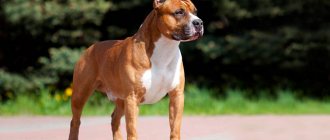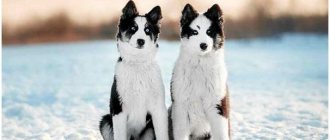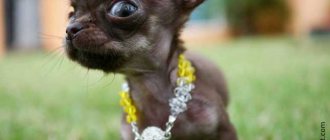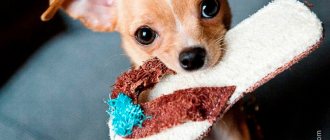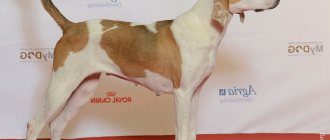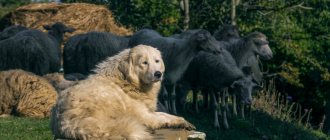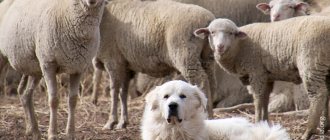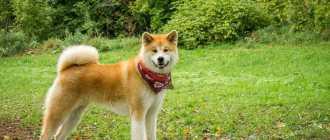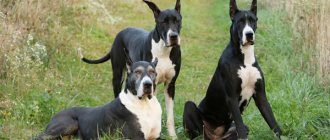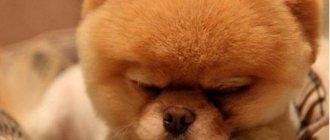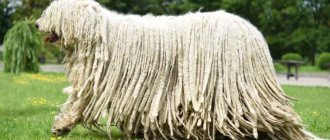Floppy ears not only add special charm to our four-legged friends, but also have a practical meaning. For example, hounds (such as the basset hound) have long ears that help them track prey by picking up and directing scents toward their noses. This explains why most floppy-eared dogs are natural hunters, bred specifically to track game over long distances.
Typically, owners of dogs with floppy ears do not experience any negative health consequences for their pets, although they do have to do extra cleaning since dogs with long ears are more prone to ear infections.
IMPORTANT! Contrary to popular belief, downturned ears do not actually affect a dog's hearing.
Basset Hound
You probably immediately thought of a basset hound when you heard “floppy ears.” Their ears appear even longer due to their elongated snout and tiny legs. Basset Hounds are stellar trackers and are easily recognized by most people. Although these dogs can be quite stubborn, they are generally low maintenance and will remain loyal no matter what.
Did you know that Basset Hounds boast the second best sense of smell in the canine world (after the Bloodhound) and are designed to track and find prey over long distances. Strong and wide paws help them quickly dig out burrowing animals.
Labrador Retriever: caring for representatives of the breed
Their thick coat should be groomed regularly. You need to brush it once a week; during the shedding period, more frequent brushing is necessary. It is advisable to bathe your pet every 2 months. Once a month it is worth trimming the nails if the dog does not comb them on his own.
You need to take care of your ears, they need to be checked once a week. If an infection is suspected, the dog should be shown to a doctor. After bathing and swimming, it is also worth cleaning your Labrador's ears. This must be done to prevent infection from occurring.
Beagle
Beagles have a huge amount of energy, which is funny because they are close relatives of the very docile and calm Basset Hound. Beagles were bred to hunt in packs, so they prefer to be around other dogs or members of their family and require a lot of play time. They are friendly and energetic family dogs, always ready for adventure. But sometimes their energy can be too much for the average family.
Interesting fact: beagles belong to the group of hounds, but, unlike them, they love to bark. And it’s not surprising, because “beagle” “screamer” in French .
Beagles are renowned for their strong sense of smell—the dogs will tirelessly track prey for miles—but they are also known for their large mouths and bottomless stomachs in addition to their luxurious floppy ears.
Smooth-haired and short-haired breeds
Smooth-haired and short-haired breeds of fold-eared dogs:
- English bulldog.
- Pointer.
- Basset Hound.
- Bloodhound.
- Boxer.
- Dogue de Bordeaux.
- Bullmastiff.
- Weimaraner shorthair.
- Dalmatian.
- Mastiff (English, Neapolitan).
- Pug.
- Rottweiler.
- Dachshund (mini, rabbit, standard).
All dog breeds are suitable for keeping in an apartment, subject to active walking. Short-haired dogs with service inclinations are successfully used in protecting private property, but they must be able to freely enter the home, especially in winter.
Dachshund
These walking hot dogs are amazingly tough little dogs. Dachshunds are actually part hound , so they have a strong sense of smell and hunting instincts. Dachshunds have quite a bold character and make excellent watchdogs despite their small size.
Although Dachshunds are not built for long distance running or jumping, they have enormous energy reserves and will be ready for any game, especially those that offer a challenge.
Briefly about the main thing
- Droopy long ears are considered by scientists to be a genetic defect maintained by selection.
- Each breed has its own standard for ear length.
- Droopy ears will require more care.
- The ears may be covered with smooth, shiny fur, fine hairs or curls.
- The general condition of the dog, its activity, and longevity depend on the health of the hearing organs.
- When choosing a breed, you need to focus on personal preferences, find out in advance the character and natural inclinations.
- Dogs with long ears have lower levels of aggression.
Bloodhound
Also known as bloodhounds, bloodhounds are the best dogs for finding missing persons. Their sharpest sense of smell in the canine world can sometimes cause trouble on walks, as they tend to sniff everything. Besides their long, floppy ears (which should be checked daily for ear infections), these hounds have a love of barking like no other. They howl at everything, which is why Bloodhounds are not the best choice for families living in cramped apartments.
Fun fact: Bloodhounds can track up to 210 km away and can follow a scent left almost a week ago. Often used in search and rescue missions, Bloodhounds are considered such accurate trackers that their tracking results can be used in court.
The long, floppy ears are an advantage for the sensitive noses of bloodhounds and add to their charming, soulful appeal. Who wouldn't want to pat the ear of this sweet pie with a sad look?
Cavalier King Charles Spaniel
These little cuties are rightfully popular among dog lovers. In addition to its adorable floppy ears and fluffy coat, the Cavalier King Charles Spaniel has a very affectionate and loving personality . With him you will get a best friend for many years. Cavalier King Charles Spaniels have the gentle and playful qualities of a toy breed, while also embodying the athleticism of a spaniel.
Cocker Spaniel
Cocker spaniels not only have long ears, but also huge hearts and brains. They are generally gentle and sensitive, but always ready to take on a challenge. Cocker Spaniels are easy to train and love to play with children. You just need to spend some extra time grooming their silky coat, but that's a small price to pay to have the best companion in the world.
This small breed is extremely intelligent, agile, playful and adorable. Their small size and boundless energy make Cocker Spaniels excellent students in agility courses, and their eagerness to please their people makes them easy to train.
However, don't let those cute eyes and gentle disposition fool you. Cocker spaniels were bred to chase birds out of the bush when hunting, so they may have a high drive for tracking prey. So it's a good idea to keep them on a leash and in a fenced yard to prevent them from escaping and disturbing local wildlife.
Kennel of Bernese Mountain Dogs and Papillons. Professional approach.
Part 1. “A striking example to illustrate the Papillon breed standard.”
Author: Vesa A. Toivanen, Finland, Connection & Siljans nursery
Translation: D.O. Mamontov, Judge RKF-FCI
There has been a lot of discussion lately about the size and breed type of the Papillon. However, it seems that the subject of this discussion is not particularly interesting to people. It seems that in some countries of Northern and Eastern Europe and especially in Russia the size and bone structure of the Papillon has increased greatly over the last 10-15 years. What will we have left if the small, elegant butterfly dog is destroyed due to ignorance and fashion?
Personally, I am extremely concerned that the wonderful Papillon breed will change in the wrong direction. I notice that in the above-mentioned countries the population is growing and people are very active and exhibit Papillons at shows. The so-called good reach and drive (that is, handlers running around in the ring), abundant plump hair and strong bones are a really big problem. The breed standard should be respected. And even though there are minor differences in the standards of the FCI, American and English Kennel Clubs, we still have to respect the fact that the Papillon is a small, elegant, stylish toy dog with an amazing history. In their historical past, Papillons have always been small and cute dogs, and we should not forget this.
I would like to post a photo from almost 30 years ago of this world famous dog named Smaragden Poker Face. This male, in my opinion, was a wonderful and very typical representative of the breed. He was the champion of Sweden, the USA and Japan, and also became the best dog in all-breed shows. In his time he was an excellent example of the breed standard. In the photo he was taken at a young age and his breed qualities are clearly reflected in it. The photograph of the head was taken by Mr. Arne Hansson (Silenzio's Nursery), and note the balance throughout, and at the same time the presence of masculinity and elegance at the same time. He really resembles a butterfly thanks to the correct ratio of the skull and muzzle, as well as due to the large and correctly set ears. Beautiful almond-shaped eyes. The standing photograph taken by the legendary Per Unden shows the correct balance and proportions of the body. A male full of elegance. The silhouette is created by beautiful lines and a correct tail. There is enough hair and at the same time, which is important , the silhouette itself is visible.
And today this dog could be the winner of major exhibitions and be an example of quality and level in the breed! True Papillon!
Part 2. Private exterior of Papillon dogs.
Selection and translation of fragments of illustrated standards, comments from breed specialists, breed judges and our own observations.
2.1. Head.
2.1.1. General form.
2.1.2. Ears
When assessing the size and shape of the ears, manual control on the part of the judge is important, since especially in young dogs, the ears may appear outwardly pointed due to hairs sticking up that have not yet reached their final length. The ear should be large with rounded ends, but not long, wedge-shaped or thin. The size and shape of the Papillon and Phalene ears are the same, and the only differences are in the set. An assessment of ear setness in a Papillon, like other dog breeds, should be carried out when the dog is in an alert state, as a relaxed dog will often hold his ears lower than when he is tense.
2.1.3. Disadvantages of the skull structure
2.1.4. Head profile: important proportions
The FCI standard only says that the muzzle is shorter than the skull. In most of the reviewed comments, the most desirable ratio of the muzzle to the skull is 1/3 to 2/3 of the total length of the head. At the same time, for example, the length of the muzzle in the AKC Standard is clearly stated as “approximately 1/3 of the length of the head.”
2.2. Frame
The Papillon is a small, elegant dog
The oblique length of the body is slightly greater than the height of the dog at the withers.
In terms of size, the FCI standard is more streamlined about a height of about 28 cm, but the weight limits are clearly indicated: males 2.4-4.5 kg and females 2.5-5 kg, minimum weight 1.5 kg. For comparison, in the American Kennel Club Standard, the height boundaries are more clear and strict: height at the withers is 8-11 inches (20-28 cm), and height over 12 inches (30.5 cm) is disqualifying. In the Australian Kennel Club and English Kennel Club Standards, the height limits are the same as in the AKC, but there is no disqualification for exceeding them.
Important
: A well-dressed dog will appear somewhat more stretched out due to the long hair on the neck and hind legs, so it is important to clarify the visual assessment of the format with a manual examination.
2.3. Limbs
2.4. Tail
The tail is quite high in set and set, relatively long according to the FCI standard (in the AKC standard: long and set high without the words “sufficient” and “relatively”). The hair on the tail of adults is long and disintegrating, the so-called “plume”. The tail is raised above the topline, ideally without the tip touching it. However, crossing the topline is not a fault. The main thing is that there is a noticeable “arch” formed by the tail. A good “arch” is checked as follows: 2-3 fingers should pass freely between the rump and the lower third of the tail at its base. Papillon breeders often compare the correct tail to the handle of a teapot.
NB! A tail thrown over the croup (“flat” in the English-speaking environment) is a serious fault and should be strictly punished by the judges.
Regarding the nuances of examination in the tail part: short tails are quite common in the breed, and a rich plume can hide this and other anatomical defects and defects. The tail, carefully lowered (straightened) with the hands, should reach the hock joint.
It is important to remember that the Papillon is not only a cheerful, attentive and sensitive dog, but also a rather gentle dog, so a manual examination should be carried out very delicately, without haste or sudden movements. In adult dogs, the weight of the tail can “lay” on the back, and that is why it is important to check how correct its base is. A tail that touches the back at the tip and visually appears “flat”, but at the same time with a correct arch at the base is absolutely correct.
2.5. Movements
The Papillon's movements should be balanced, light and free, without any cohesion or stiffness. A true Papillon moves with dignity and grace.
As the speed at the trot increases, the forelimbs begin to tend closer to the central longitudinal axis, but at the same time the limbs are carried strictly forward, the elbows and knees do not turn outward or inward. Overlapping movements of the forelimbs are a significant fault. During movement, the back remains strong and straight. As for the features of showing the Papillon in the ring, it should be remembered that the Papillon is a small, cheerful toy dog; a free display should be present in the ring and encouraged as much as possible, in which the Papillon plays, demonstrates contact with the handler, is cheerful, sweet, smart and interested in what is happening. expression.
As an example of balanced movements and correct presentation, the following two videos can be cited:
https://www.facebook.com/MiSs.VeRyLee/videos/10206681159174552/?hc_location=ufi
2.6. Wool
“The coat of an adult, well-dressed Papillon should not create the feeling of a dense blanket. Sunlight should penetrate through it, and there should be a feeling that each hair close to the body shimmers separately from the other and, if there was a lot of time, it would be possible to count each one separately” (Author of this artistic, but at the same time very accurate the definition of the correct coat is not known).
Breed judge Annukka Paloheimo, Finland: “Papillon hair is a big problem all over the world. Because now there are a lot of dogs with excessively thick, heavy hair, the hair has become too abundant.
And too often you find coat with undercoat, so I had to reduce the rating to "very good" for dogs of a fine breed type precisely because of the irregular coat.
And this needs to be monitored. Of course, it looks very impressive when your dog has a lot of hair, thick and long, but the Papillon should be dressed so that the hair does not hide the dog's physique. You should see the shape and lines of his body, and the coat only gives the Papillon additional elegance, but its volume and quantity are not defining characteristics, as in the Lhasa Apso or Afghan Hound. So you need to pay attention to this. And I would rather have a Papillon with a little hair than with too much.”
Weimaraner
Weimaraners are elegant dogs that are always ready for adventure. They need plenty of exercise and love to play with their people. This breed is incredibly loving and easy to train , making Weimaraners excellent family dogs as long as they get enough exercise.
The dog lowers its ears
Many times we wish we could better understand what our dog wants to tell us. But animals have their own language and use a communication system with rich body language that allows them to communicate with their peers and interact with the environment around them.
Our dog's body conveys a lot of information about his state of mind, his health and how he interprets the world. Of course, you already know that his tail and ears take on a different position according to the emotions he experiences and the sensations he perceives. To find out why your dog lowers his ears when you pet him, we invite you to continue reading this new article.
Afghan Hound
Let's be honest, this breed has nicer hair than most people we know. The Afghan Hound is a unique breed with a long, extravagant coat that adorns their ears, making them appear even droopier. These dogs tend to be quite sensitive emotionally, but are extremely loyal to the people they form a bond with.
Did you know that this adorable breed is known as the "Queen of Dogs" . And it's not hard to see why. From long, flowing ears to soft, luxurious fur, these dogs are made for photo ops.
Unlike other hounds with large ears, the Afghan Hound is only a hunter in appearance; it excels in dog racing. They are very intelligent dogs and have a fairly independent nature, which makes them difficult to train.
Choose by size
Any pet needs to be provided with a decent standard of living, because some dogs are undesirable to keep in an apartment, while others are absolutely not suitable for living in a house.
Small breeds
Small breeds are optimal candidates for living in an apartment, traveling together and having leisure time. Almost all small dogs are loyal companions and quickly adapt to the owner's lifestyle.
The Affenpinscher is an unusual, intelligent companion dog. Representatives of the breed are easy to keep and easy to train.
Griffon (Belgian, Brussels) are related breeds that are externally similar to the Affenpinscher. Representatives of the breed are good with children and travel relatively easily. Dogs of this breed have a sharp mind and good intuition.
This is interesting! The griffin is a breed group that includes small and medium-sized breeds, and the larger four-legged ones have a specialization - they are hunters.
Bichons (Frise, Havanese) are small, companion dogs with luxurious coats. Bichons are cut in a variety of ways, giving their silhouette an unusual shape. The special structure of the coat allows the hairs to rise when shortened. If a dog has long hair, it falls down, and when clipped, the dog looks like a ball of fluff.
Golden retriever
The Golden Retriever is one of the most popular dog breeds in the world, and for good reason. This dog of extraordinary beauty is used in a variety of capacities, including as a working dog for field work, guide dogs for the blind, service dogs for search and rescue of victims, and companions for children and the elderly. Golden Retrievers are loyal, playful, and very easy to train.
Saluki
These exotic dogs are avid hunters with great strength and endurance. Slender but strong, Salukis are known as agile sprinters who love a good run. But, despite their sporting nature, Salukis are quite gentle and loyal pets.
Did you know that the Salukis were held in such high esteem in Egypt that their bodies were often mummified like the bodies of the pharaohs.
Saluki is one of the oldest dog breeds. This sighthound has been used by Arabs for thousands of years to hunt gazelles. Graceful and independent, Salukis do best with daily exercise. They shed little but require weekly brushing and occasional bathing. Many Saluki owners use a headband to keep their ears away from the food bowl.
Fear/nervousness
Perhaps one of the most understandable meanings of a dog laying their ears flat is a signal that they are afraid of something, or at least wary of something. This may be especially true if you see this signal in combination with other "frightening" body language.
A frightened or excited dog may also yawn and lick its lips and avoid eye contact (it may simply not look at you or turn away from you completely).
Having an expression in the eyes that is so enlarged that you can see a stripe of the whites of the eyes (called a "whale eye"), holding the tail down and close to the body, crouching low, and/or keeping their body away from anything that makes them nervous.
Havanese Bichon
These perky little furballs are full of cheerfulness and energy. Havanese Bichons are native to Cuba . In addition to their floppy ears, they also have a luxurious coat that needs grooming more often than other dog breeds. Be sure to check their ears often to remove wax and wipe the inside of their ears with a paper towel from time to time.
Why do they love fold dogs?
Dogs with drooping ears or “loop-eared” breeds are a large group whose exterior was formed artificially. The advantages of lop-eared dogs are as follows:
- The auricle is protected from wind and dust.
- The ear canal is protected from water.
- During a fight, you are less likely to get serious head injuries - your ears will suffer.
- The expression on the face of the “floppy cat” is cuter and more trusting.
Minuses:
- Ears pressed to the head are a provoking factor for inflammatory processes if the dog does not receive quality care.
- It is more convenient for ticks to hide under drooping ears.
- Ears get dirty while eating.
Setter
There are several different setter breeds, including the Irish Setter, Scottish Setter and English Setter - all of which have floppy ears. Setters are native to the United Kingdom and Ireland and are ideal for those who enjoy hiking and hiking . Setters are happy when they have the opportunity to run through forests and fields, up and down hillsides.
IMPORTANT! Setters like to keep an eye on their surroundings, looking out for intruders. This same desire to guard their space can make them want to prowl, so it is recommended to keep these sweet sporting dogs on a leash or in a secure, fenced yard.
Coonhound
Originally bred in the USA, these hard-working, long-eared hunting companions are highly skilled at tracking raccoons, foxes, possums, deer and bears. Their second name is “coon hounds” . The Coonhound hunts equally well alone or with a pack, and can handle even the most difficult terrain. Coonhounds are renowned for their speed and endurance. This athletic hound needs regular exercise to stay in shape.
Fun fact: The breed originated in the late 1700s when hunters in the southeastern United States crossed bloodhounds and foxhounds to create a new hound that could independently track prey and follow tracks over long distances.
Coonhounds are outgoing, playful, and friendly with both people and other dogs. While they may be enthusiastic about chasing, say, a squirrel whizzing by, they're just as happy laying on the couch with their family. However, do not let them remain alone for long, otherwise they will let the whole area know about it with their mournful howl. But the breed’s hard coat does not require special care, and this is a good advantage.
What to look for when choosing a puppy
When choosing an eared dog, you need to pay special attention to its appearance and behavior. These factors are the main indicator of the health of the animal.
Criterias of choice:
- eyes - symmetrical, not slanted, without swelling or inflammation;
- ears are clean, the puppy should not constantly scratch them;
- the coat is smooth, shiny, without bald spots, flaking and parasites;
- teeth - without plaque or bruises on the gums;
- paws are strong, straight, ensuring confident movement of the dog.
When looking at the puppy, it should not appear too plump or thin. When purchasing, you need to ask the seller for a puppy card and a veterinary passport, confirming compliance with the standard, as well as the presence of the necessary vaccinations.
Important! A purebred purebred dog cannot be cheap.
The body structure of any puppy, even a dwarf breed, must be strong
Poodle
Intelligent, graceful, and amazingly athletic, poodles were originally bred as hunting dogs. Their bouncy, curly fur does not shed much and serves as an excellent insulating layer in cold or humid climates. Of course, poodles require quite a bit of grooming, whether they have the typical lion cut or you prefer to comb their locks.
Poodles are easy to train due to their intelligence and eagerness to please, and they also excel in sports such as tracking and agility. It is also worth noting that poodles are excellent swimmers, competing with Labradors and golden retrievers.
What do different ear positions convey?
Here we show the importance of a dog's ear position in order to become better at interpreting body language in general:
- Twists and slightly forwards slanted ears : indicates that the dog is paying attention to some stimulus and is trying to interpret its meaning. If a stimulus captures most of their attention, the animal may move its head to both sides.
- Twists and tilts ears very forward : the dog is very alert. He may also show an abusive attitude towards any stimulus or other animal. If, in addition, the animal looks, wrinkles its muzzle and shows its teeth, it is preparing to attack.
- Twisting ears, tail and body, leaning forward : this position usually indicates that the dog is very alert and ready to attack. This can happen when one dog is dominant over another. We could also observe bristly hair, stiff limbs and very dilated pupils.
- Ears back : A dog usually curls his ears back when he feels fear or uncertainty. If the animal also tilts its head, puts its tail between its legs and has half-open eyes, this means that it is very scared.
- Ears back and body crouched : If we observe a dog with ears back, body flexed, bristly coat and mouth very open, the dog is showing a posture of defensive aggressiveness.
As we've explained, every dog has unique ears and special characteristics. We must be able to distinguish the "relaxed" posture that an animal takes on when it is quiet from those that show some type of communication. This may be difficult to interpret in some cases.
If you notice that your dog is constantly afraid, you should consider the 5 Animal Welfare Freedoms to try to find out if he is suffering from stress or a health problem. Also, contact your veterinarian to evaluate any potential behavioral problems.
However, pinched ears are not always a bad sign. In fact, the mood considered ideal for a dog is characterized by a friendly posture in which his mouth and eyes are wide open, his tail tucked and moving happily, and his ears relaxed back.
Bedlington Terrier
The Bedlington Terrier a hardy breed known for its curly coat, was bred in England in the 19th century to catch rats, mice and other rodents. The graceful shape of the body gives the Bedlington Terrier the ability to develop great speed and gives it endurance. Soft and gentle, with a sweet personality, this breed makes a wonderful family companion. The Bedlington Terrier is an energetic but not overly exuberant pet that needs daily exercise. His coat requires regular trimming.
Did you know that the Bedlington Terrier was popular with the Rockefeller family? After William A. Rockefeller's dog Timmy won the Westminster Kennel Club Dog Show in 1948, it wasn't just hunters who became interested in Bedlington Terriers.
Why do dogs lower their ears when we pet them?
Dogs move their ears as a sign of calm, which indicates well-being, complacency, or affection. They may also do this to ask for food, and even when we get angry at him after some misdeeds, it is his way of saying “please stop.”
It may happen that if we also notice that she is clenching her body or that she is tucking her tail back, this means that the petting is too cool. In this case, he shows fear to ask us to be careful - he is afraid.
But in any case, if our dog puts his ears back when it is quiet, he will ask for your attention.
Boykin Spaniel
An avid hunter, the Boykin Spaniel is also an affectionate dog that enjoys the company of people and other animals. With a cheerful temperament, the Boykin Spaniel is especially good with children . This energetic breed needs plenty of exercise and thrives in an active family. The Boykin Spaniel's coat ranges from smooth to wavy and requires regular grooming.
Fun fact: The Boykin Spaniel is the official state dog of South Carolina. The first Boykin Spaniels were bred from two strays owned by L. Whitaker Boykin, after whom the breed was named.
The Boykin Spaniel is an excellent upland game and waterfowl hunter and a good turkey dog.
Breton epañol
This is an excellent hunting dog, able to point at game and retrieve it from cover. Strong, fast, agile and alert, the Breton Spaniard is good-natured and friendly, making him a good companion for families. The breed has thick fur, which protects the pet in field conditions and requires regular grooming. This energetic breed needs daily exercise and does well in a family that enjoys outdoor activities .
Did you know that the Breton Spaniole originated in the French province of Brittany, where the breed was first shown in 1896? But back in the early 1700s, paintings by Jean-Baptiste Oudry showed this white and brown dog stalking partridges.
German dog
The name of the breed combines several names of breeds - Great Dane, English Great Dane, Great Dane - and is distinguished by coat color and size. The dog is a giant; there is no upper limit to the breed's height. The standard sets only the lower limit (for a male - from 80 cm at the withers, for a female - from 72 cm). The first image of the direct ancestor of the Great Dane is found in paintings of the 15-16th century. The Great Dane is a large, powerful, but calm dog. Used as a companion or bodyguard. Great Danes are balanced, calm animals that demonstrate dignity and strength. They have a good memory, so they are easy to train. Education and training can be complicated only by the slowness of giants.
Harrier
A strong, muscular harrier is an English pack hound originally bred to hunt hares. As an active bloodhound, the Harrier requires moderate exercise to maintain its strength and stamina. This inquisitive hunting breed should be kept on a leash or in a fenced area. Its short, dense coat requires minimal grooming. Sociable and loyal, the Harrier loves to be around people and other dogs.
Did you know that the Harrier was bred from the English Foxhound. Sir Elias de Midhope bred the first pack of these hounds at Penistone in 1260.
How to choose a breed
What to consider when choosing a pet? Please note the following factors:
- The growth of the animal and your living conditions - house, apartment, room. How many square meters can you provide for a four-legged friend - 2 or 20 square meters of a hall or corridor. The larger the area of the room, the more freely you can place a large animal in it.
- Characteristics – even among lop-eared dogs there are open/sociable and wayward ones. It is not always possible to influence a genetic predisposition to unauthorized acts.
- Receptiveness to training. If you want to get a dog that is poorly receptive to following commands, you will need more training with a dog handler to accustom the animal to following commands and actions.
- What type of coat is it – dense, close-fitting, shaggy, thick. The type and length of the coat determine the amount of grooming for the animal, as well as washing and vacuuming of home floors and carpets.
Your personal sympathy is very important. After all, a dog is a future friend. It is desirable that the appearance of the animal, its color, and behavioral characteristics are deeply attractive to you. Therefore, do not choose a breed under the influence of fashion, analyze your emotions and sensations.
Saint Bernard
A massive and powerful dog, the Saint Bernard was originally bred in Switzerland to rescue travelers stranded during a snowstorm. The breed has two varieties: short-haired and long-haired. Both species have a gentle temperament , making the noble and intelligent Saint Bernard an excellent companion and devoted family dog. But be aware that this breed drools a lot and its coat sheds frequently, requiring regular grooming.
Did you know that the breed was named after Saint Bernard de Menton, the patron saint of climbers and skiers.
Leonberger
Often called a "gentle giant" , the muscular, massively boned Leonberger is distinguished by its lion-like mane and black muzzle. This German dog breed was developed in the mid-1800s as a versatile working dog and family companion. Calm and playful, the Leonberger has a balanced temperament and is always ready to please his loved ones. Its thick, waterproof fur should be brushed daily to avoid matting.
Fun fact: The Leonberger is a cross between a Newfoundland, a Pyrenean mountain dog and a St. Bernard created by Heinrich Essig in 1846 in Leonberg, Germany. A famous German dog handler tried to recreate the lion depicted on the city coat of arms in dog form.
